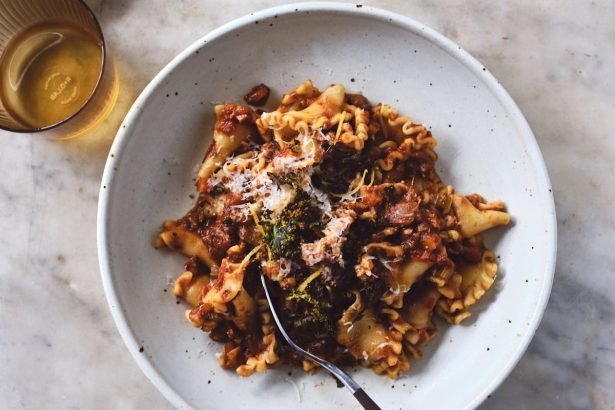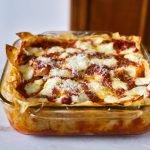The ragù of your dreams. This hearty and deeply flavorful mushroom ragù moves from the stovetop to the oven, slow-cooking into a hearty, wonderful sauce featuring finely chopped mushrooms, tomatoes, white wine, and aromatics.
Most of the mushroom ragù I’ve cooked in my life featured sliced mushrooms. I’d brown them and work from there. Eventually, this style of sauce fell out of rotation and I didn’t give it much thought. Other sauces took its place and I never looked back. It wasn’t until I saw an early copy of Cooking With Mushrooms that mushroom ragù became a regular feature again in our house. Andrea’s ragù features a mixture of very finely chopped fresh mushrooms. It is slow cooked in a low oven for hours, and has all sorts of wonderful wildcard ingredients in it adding layers of depth and flavor – nutritional yeast, fish sauce, mushroom powder, chiles and herbs. You should buy her book, and you should absolutely make her version (vegan fish sauce works great in it if you’re veg). It’s one of my favorite ways to spend a lazy Sunday.

When a lazy Sunday isn’t quite in the cards, I regularly find myself making what I’ve come to think of as my “cheater version” of the ragù. It happens when I know I’m a bit short on time, or out of certain ingredients — that’s the recipe you see here. It’s thick, hearty and the perfect paring for a range of pastas, polenta and the like. I love it enough to always have in my freezer these days. 
Secrets to Making a Great Ragù
Generally speaking, I feel like there are two primary secrets to making a great mushroom ragù — quality ingredients and patience. On the ingredient front, choose mushrooms that are firm and dry. Avoid mushrooms that are discolored, mushy, or wrinkled. It likely goes without saying, but mushrooms that have an off-smell or have any sort of sliminess should also get a pass. Gross, I know. Patience kicks in on the cooking front. This ragù starts off quick saute on the stovetops and then moves into a low-and-slow couple of hours in the oven.
Cooking Method
By sautéing ragù ingredients on a stovetop and following up with a couple hours in an oven you achieve a thick, wonderful concentrated hearty sauce. I love the combination. 
Mushroom Ragù: Core Ingredients
There’s quite a lot of flexibility here. Give the recipe a try as written, and then wing it a bit moving forward based on what you have in your kitchen. For example, I’ve used scallions (with the green parts) when I was out of onions, and I really loved that version as well.
- Tomatoes: I tend to keep crushed tomatoes on hand, so that’s what I use more here often than not. Fire-roasted canned tomatoes are my first choice, but standard crushed tomatoes are a-ok if that is what is available. In Andrea’s version she has you blitz whole canned tomatoes into a puree. Each choice brings something slightly different to the ragù, so feel free to experiment!
- Mushrooms: I talked about the importance of mushroom quality in the previous section a bit. Here I’ll talk about types of mushrooms that work well. I love to use a mix of flavorful mushrooms in a ragù like this. You can mix up the types of mushrooms depending on what is available in your area. I rarely use them same combination twice. Oyster mushrooms are meaty and firm and hold their texture in the sauce. Because of the sheer amount of mushrooms needed for a ragù, supplementing common (and less expensive varietals) with something more special and unusual is a good approach. Generally speaking, cremini, oyster, Portobello, maitake and button mushrooms are a great place to start.
Mushroom PowderPorcini powder is a powerhouse ingredient and adds depth and an added layer of flavor beyond the fresh mushrooms. You’re doubling down on flavor. I know it can be tricky to track down, but it’s an ingredient I wouldn’t skip here. You can blitz your own dried porcini into a powder with a high-speed blender. Because this has become such a go-to sauce for me, I tend to stock up on porcini mushroom powder, either homemade, or from a trusted source like Far West Fungi.







